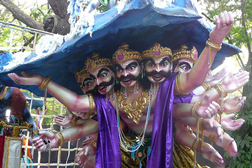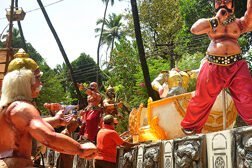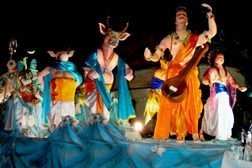No products in the cart.
HINDU GOA CELEBRATES THE SHIGMO FESTIVAL THE KONKANI WAY
Goa : Shigmo Festival which kicks off on March 26 to April 8th ,2024
While our memories still resonate with the shiny images of Goa’s Carnival and its Portuguese impress, there are a whole bunch of travellers out there who are unaware of the rainbow-coloured celebrations of Hindu Goa’s Shigmo Festival, that’s been deeply embedded in Konkani culture for centuries on end.
The multi-day Shigmo Festival which kicks off on March 26 to April 8,2024 demands a special place on your social calendar. So, there’s no excuse to miss the celebrations as they are held on different days in several towns across the state, each one fashioned to meet the local way of going festive.
A culturally vibrant region the Konkan, cocooned between the Arabian Sea and the Western Ghats, is a narrow strip of land in Peninsular India’s western coastal belt. Its lazy sprawl of about 530 km stretches between South-western Maharashtra to Southern Karnataka, from present-day Thane district in Maharashtra to Goa. Its cultural expressions are defined by its language (largely Marathi and Konkani, a dialect of Marathi), folk traditions and influences from a Naga lineage known as ‘Kunkan’ which originally ruled the region for a long time. It lends voice to the ancient culture of serpent (naga) worship that is common amongst Hindus in the region. Worship also largely revolves around folk deities such as Kalika, Amba, Bhairava, Bhoothnath etc. The land is also closely connected to the legend of Lord Parashuram, who is said to have reclaimed this land from the sea by shooting arrows in the waters.
“Shigmo” is a Konkani term, inspired by the Prakrit word ‘Suggimaho’ and the Sanskrit word, Sugrishmaka. There are two varieties of the Shigmo festival, the Dhakto Shigmo and the Vhadlo Shigmo. The Dhakto Shigmo is celebrated by the rural population, farmers and the labour class, whereas the Vhadlo Shigmo is of greater importance and is celebrated by all.
The essence of Shigmo captures Goa’s pre-Portuguese-era nuances with its fusion of Hindu myth and mysticism, as also the riches of Konkani folklore, traditions and beliefs.
A vibrant welcome to the season of Spring Shigmo is also firmly rooted in its historic importance— of a heartwarming welcome to the warriors who had set off after the Dusshera celebrations to fight the Portuguese invaders.
Shigmo offers a fantastic window to Konkani culture and heritage with its fabulous mix of rituals and dances, parades and procession, as also a palate-tantalising culinary exposition.
photo support by : www.shigmofestival.org
Parades and Processions
An ideal opportunity arises to replace those vignettes of Carnival during the vibrant Shigmo parades and processions following designated routes to the delight of the line-up of hundreds of viewers. Throngs of festive people gather around to catch selfie and Insta moments of this glorious cultural extravaganza. Gaily decorated floats with various themes, colourful folk dances by performers costumed in traditional getup teamed with jewellery and headgear are just some of the bright facades of this elaborate cultural canvas.
Performers dressed to replicate the deities like Veerbhadra, the son of Lord Shiva, and Hanuman, go all out in donning elaborate costumes and make-up, keeping the crowds thrilled with their inventive makeovers. Dolled up ladies join the hectic pace, dancing to the tune of their musical instruments known as Lezim. Traditional musical instruments like shamels, jhanj, dhol (drum), tasha (drum) and kasale (cymbals)—and lively brass bands, keep the tempo going, adding an upbeat air to the entire experience. Dance performances which mark the festivities are the ever-popular Ghode-Modni (horse dance). This involves the male performers in warrior getup wielding swords while balancing the effigy of a horse tied at their waists. The dance is held in honour of the returning heroes who, after Dussehra, went off to fight the Portuguese invaders. Thane is considered the best place to view this exceptional performance. Romtamel is a dance where the dancer holds makes his moves holding up two tarangas or holy standards. A float might feature the ‘Virat’ manifestation of Lord Vishnu, while others could depict demons and deities such as Shiva as Adiyogi, from Hindu mythology.
The Rituals of Dance and Deities
You can also enjoy the opportunity of a showcase of a now declining tradition of Maand or rituals in a sacred space. This is a very old ritual played out in a sacred space in the village square to invoke the deities. The Veerbhadra dance form, organized in a sacred space at the Vithoba temple in Ponda, symbolizes the fight against injustice. This ritual dance form, involving two swords, is held once during the Dhalo festival and then during the Shigmo Festival when he also walks barefoot on fire holding a torch. The torch-bearing Veerbhadra is symbolic of the deity as light giver and the sword wielding the protector. You can also catch a dance performance of Kunbi by the tribal women; this is a very ancient dance tradition in local folk culture in Salcette district. Day-5 of the festivities is known as Rang Panchmi and marked by a frenetic use of ‘Gulal’ Holi-style.
Evenings of the Shigmo Festival are no less hectic, given the line-up of short plays of anecdotes pulled out of myth and memory, complete with gorgeous costumes and high-octane performances
If you are travelling around the villages of Sal, Kudne and Pilgao in Bicholim District you’ll be able to catch a ritual performance that is unique to these villages. Also known as Gade Utsav, it involves the appeasing of the deities as the guardians of the villages against natural calamities and evil spirits. In particular it is dedicated to Lord Mahadev, the Patron of Ghosts.
Feasting is an intrinsic part of celebrations with home cooked Goan dishes like sannas, vindaloo, xacuti, and a variety of sweets and desserts being shared with family and friends during the celebrations.


























